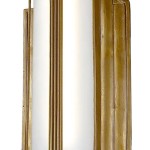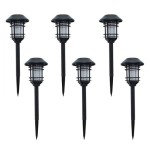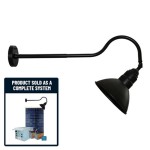How To Weatherproof Painted Wood Furniture For Outdoors
Painted wood furniture can significantly enhance the aesthetic appeal of outdoor spaces, providing comfortable seating and stylish accents. However, exposure to the elements can quickly degrade the paint and wood if proper weatherproofing measures are not implemented. This article details how to weatherproof painted wood furniture to protect it from moisture, sunlight, temperature fluctuations, and other environmental factors.
Preparation is Paramount: Cleaning and Inspection
Prior to applying any weatherproofing treatments, thorough preparation of the furniture is crucial. This involves cleaning the surface to remove any existing dirt, mildew, or loose paint. Start by brushing off any loose debris with a stiff-bristled brush. For stubborn dirt and mildew, a cleaning solution comprised of water and mild detergent can be used. Apply the solution with a sponge or cloth, scrubbing gently to avoid damaging the paint. Rinse the surface thoroughly with clean water and allow it to dry completely. This drying process may require several hours or even a full day, depending on the humidity and temperature.
After cleaning, a comprehensive inspection of the furniture is necessary. Look for any signs of damage, such as cracks, chips, or peeling paint. Addressing these issues before weatherproofing will ensure a more effective and long-lasting result. Small cracks can be filled with exterior wood filler, applied according to the manufacturer's instructions. Allow the filler to dry completely and then sand it smooth to blend with the surrounding surface. Loose or peeling paint should be scraped away with a paint scraper or wire brush. Once all loose paint is removed, the area should be sanded to create a smooth surface for new paint or primer.
Addressing existing damage is crucial because these imperfections can act as entry points for moisture, accelerating the deterioration of the wood. Furthermore, failing to repair damage before applying a sealant or topcoat can trap moisture underneath, leading to further problems such as rot and mildew growth.
Selecting the Right Products: Primer, Paint, and Sealant
The effectiveness of any weatherproofing strategy hinges on choosing the appropriate products. This includes selecting a primer, paint, and sealant that are specifically designed for exterior use. Each of these products plays a critical role in protecting the wood from the elements.
A high-quality exterior primer is essential for creating a strong bond between the paint and the wood. Primer also helps to seal the wood, preventing moisture from seeping in and causing damage. Choose an oil-based or acrylic latex primer specifically formulated for exterior use. Oil-based primers are generally more resistant to moisture and provide better adhesion, but they require more time to dry and can be more difficult to clean up. Acrylic latex primers are easier to apply and clean up, and they offer good flexibility to withstand temperature fluctuations. Apply the primer evenly, following the manufacturer's instructions regarding drying time before proceeding with the paint.
The paint itself should also be specifically formulated for exterior use. Exterior paints are designed to withstand exposure to sunlight, rain, and temperature changes without fading, cracking, or peeling. Acrylic latex paints are a popular choice for outdoor furniture due to their durability, flexibility, and resistance to mildew. Oil-based paints offer superior durability and moisture resistance, but they tend to yellow over time and are more susceptible to cracking. When selecting a paint color, consider the amount of sunlight the furniture will be exposed to. Darker colors absorb more heat, which can cause the paint to fade or blister. Lighter colors reflect sunlight, helping to keep the furniture cooler and extending the life of the paint.
Finally, a sealant or topcoat is crucial for providing an extra layer of protection against the elements. Choose a clear, waterproof sealant specifically designed for exterior use. Polyurethane sealants are a good option for painted wood furniture as they provide excellent durability and resistance to abrasion. Apply the sealant evenly over the painted surface, following the manufacturer's instructions regarding drying time and application. Reapplication of the sealant may be required periodically to maintain optimal protection, typically every one to two years, depending on the severity of the weather conditions.
Application Techniques: Ensuring Proper Coverage and Adhesion
Even with the best products, improper application can compromise the effectiveness of the weatherproofing process. Attention to detail and adherence to proper application techniques are essential for ensuring optimal coverage and adhesion.
Before applying any product, ensure that the furniture is clean, dry, and free of any loose debris. Stir the primer, paint, or sealant thoroughly to ensure a consistent consistency. Apply each product in thin, even coats, using a high-quality brush, roller, or sprayer. Avoid applying thick coats, as this can lead to drips, runs, and uneven drying. Allow each coat to dry completely before applying the next, following the manufacturer's instructions regarding drying time. Multiple thin coats are generally more effective than a single thick coat in providing thorough coverage and protection.
When applying primer and paint, pay particular attention to edges, corners, and hard-to-reach areas. Use a small brush to apply the product to these areas, ensuring that they are completely covered. For larger surfaces, a roller can be used to apply the product quickly and evenly. When using a sprayer, maintain a consistent distance from the surface and use a smooth, even motion to avoid creating uneven coverage or runs.
After each coat, inspect the surface for any imperfections, such as drips, runs, or missed spots. Address these issues promptly to ensure a smooth and professional finish. Lightly sand any drips or runs before applying the next coat. Use a fine-grit sandpaper to avoid damaging the painted surface. If any areas are missed during application, touch them up before the next coat to ensure complete coverage.
Proper drying time is crucial for ensuring that the primer, paint, and sealant adhere properly to the wood. Avoid placing the furniture in direct sunlight or allowing it to be exposed to rain or moisture during the drying process. A well-ventilated area will help to speed up the drying process. Follow the manufacturer's instructions regarding drying time for each product. Rushing the drying process can result in a compromised finish that is more susceptible to damage from the elements.
Ongoing Maintenance: Protecting Your Investment
Weatherproofing painted wood furniture is not a one-time task; it requires ongoing maintenance to ensure long-lasting protection. Regular cleaning and inspection can help to identify and address potential problems before they escalate.
Clean the furniture regularly with a mild soap and water solution to remove dirt, dust, and mildew. Avoid using harsh chemicals or abrasive cleaners, as these can damage the paint and sealant. Rinse the furniture thoroughly with clean water and allow it to dry completely. For stubborn stains or mildew, a solution of diluted bleach can be used, but be sure to test it in an inconspicuous area first to ensure that it does not damage the paint.
Inspect the furniture regularly for any signs of damage, such as cracks, chips, or peeling paint. Address these issues promptly to prevent further deterioration. Small cracks can be filled with exterior wood filler and touched up with paint. Loose or peeling paint should be scraped away and the area sanded before applying a new coat of primer and paint.
Consider covering the furniture during periods of inclement weather, such as heavy rain, snow, or extreme heat. This will help to protect the paint and wood from the elements and extend the life of the furniture. Store the furniture indoors during the winter months, if possible, to prevent damage from freezing temperatures and snow. If indoor storage is not an option, cover the furniture with a waterproof tarp and store it in a sheltered location.
Reapply the sealant or topcoat periodically, typically every one to two years, to maintain optimal protection. The frequency of reapplication will depend on the severity of the weather conditions and the type of sealant used. Inspect the sealant regularly for any signs of wear or damage, such as cracking or peeling. If necessary, lightly sand the surface before applying a new coat of sealant to ensure proper adhesion.
By following these steps, painted wood furniture can be effectively weatherproofed, providing years of enjoyment and enhancing the beauty of outdoor spaces.

How To Paint And Prime Outdoor Furniture

Is Painted Outdoor Furniture Weatherproof Luxury

How To Seal Wooden Furniture When You Move It Outdoors

How To Protect Outdoor Wood Furniture Osmo

How To Waterproof And Seal An Outdoor Table With Milkoil Miss Mustard Seed S Milk Paint

How To Waterproof Wood With Oil Sealant Or Stain And Sealer Bob Vila

How To Repurpose Indoor Furniture For Outdoor Use

Tips To Using Acrylic Paint On Wood

How To Paint And Prime Outdoor Furniture

How To Waterproof Wood With Oil Sealant Or Stain And Sealer Bob Vila
Related Posts







